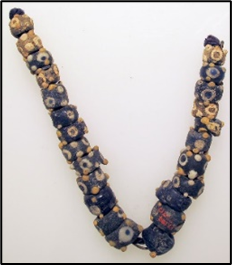Phoenician Glass beads as individual tokens
Baroness Ginevra Lucia Di Namoraza
 |
| Image 1 |
 |
| Image 2 |
A selection of handmade glass beads in the
Phoenician style to use as individual tokens or to add to other gifts such as
pouches or tassels.
1.Beads in Politarchopolis colours for the
Baron and Baroness to hand out. 10 in a bag.
2.Beads in Lochac colours for
Politarchopolis to give as largesse to Royalty. 10 in a bag
3.Beads in House of Hurts colours- a gift for
the personal use of the Baronage. 10 in a bag.
 |
| Image 3 |
The Phoenicians occupied the coast of the Levant - eastern Mediterranean.
When?
4th- 3rd century
BCE
Details of the extant pieces:
Dimensions as an example from the Met Museum
glass beads:
Diameter (smallest bead): 3/8 in. (0.9 cm)
Diameter (largest bead): 5/8 in. (1.6 cm)
 |
| Image 4 |
Details of the Recreation:
I chose to recreate several beads that are on display
in a variety of museums to ensure historical accuracy. I worked with each
museum's high-resolution images to recreate the piece with their unique
characteristics. These beads can be from 15 to 45 minutes of work each. I
followed the average dimensions that these beads were found to have. My
preferred aesthetic is a precise number of dots and layout, though you can see
that this design choice is used, as well as a looser approach. The House of
Hurts and Lochac beads have a commonly used colour scheme, though creative
liberty was taken for the Politarchopolis bead. Red glass can however be found
amongst beads in this timeframe and location.
I used a graphite paddle, mandrels, bead
release, a knife, fire annealing and gravity. I try to use the least tools
possible and authentic equipment that would have been used by the glassmakers
of the time. I use a hot head torch and MAPP gas. In the future I have plans to
recreate a small portable kiln but melting glass in a small kiln is very
difficult as getting the heat hot enough to melt the glass is a struggle. Instead
of annealing them in a furnace, I use a product called vermiculite to allow the
beads to cool down slowly. I also use a kiln. In the future, I would like to
try annealing them in a furnace to see what it is like. Image 3, 4,10 are my recreation.
 |
| Image 10 |
Future Projects:
I will continue to donate prizes and
tokens as I have seen firsthand the joy of a unique, handmade token.
Resources: High-Resolution
copies of the extant beads.
Image 3, 4: My own work
Image 5: https://www.metmuseum.org/art/collection/search/249950
Image 6 : https://www.mdpi.com/1996-1944/15/16/5740
Image 7 : https://balkancelts.wordpress.com/tag/bulgarian-evil-eye/
Image 8 : https://www.metmuseum.org/art/collection/search/552040
Image 9:
https://laterprehistoricfindsdotcom.files.wordpress.com/2017/08/lpfg-newsletter-issue-4.pdf
Image 10 : My own work






No comments:
Post a Comment